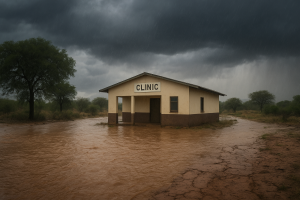SA’s extreme weather places remote healthcare facilities at risk
6 min read
Floods in the Eastern Cape, tornado-like storms in KwaZulu-Natal, repeated heavy rains in the Western Cape, and drought and water scarcity in the country’s interior are a few of the many events that have damaged clinics, cut off patient access, and disrupted delivery of life-saving medicines in the past few years. Even outside of major disasters, clinics in geographically remote areas are often left vulnerable to extreme heat, extended cold snaps, and torrential downpours, each placing new burdens on facilities.
“Climate-resilient infrastructure is one of the most effective ways of safeguarding healthcare access in outlying areas in South Africa,” notes the Gap Infrastructure Corporation’s (GIC) CEO, Roelof van den Berg. “As weather patterns become more unpredictable, the threat to healthcare facilities will only grow – a single flood could risk washing away vital access roads, or strong winds could strip roofs from buildings, leaving people and equipment exposed.
“But by investing in stronger structures, better drainage, and reliable road links, we can make sure that clinics continue to serve communities even when conditions are at their worst. At the end of the day, infrastructure built with resilience in mind ensures continued public access to critical healthcare facilities, protecting lives and livelihoods.”
The human impact of vulnerable infrastructure
In remote communities, healthcare access depends on the availability of doctors, nurses, medical equipment, medicines, and whether patients can reliably reach these facilities. Low-income households typically rely on public transport or walk long distances to get to a clinic. In some cases, this may involve crossing unpaved roads vulnerable to flooding, which means that heavy rains can block access to the nearest clinic.
Extreme weather poses a threat to facilities as well. Strong winds have torn roofs from clinics, storms have left walls waterlogged, and electrical systems may be damaged by heavy rain. Fixes can involve anything from new roof trusses and corrugated iron sheets to drainage systems, sewer lines, and boundary fencing – often costing anywhere from a few thousand to millions of rands.
Drugs and medical equipment are also at risk. Refrigerated storage for vaccines and chronic medicines can fail during power outages, while leaks and flooding damage diagnostic equipment.
Weather also severely impacts people’s health. Prolonged heat waves increase cases of dehydration, heat stroke, and vector-borne diseases. Cold snaps result in more respiratory illnesses. Floods and storms can trigger injuries and waterborne diseases. For small provincial clinics with limited beds and staff, a sudden surge in demand is overwhelming.
“We urgently need solutions that ensure buildings remain operational during extreme events, so that patients can reach clinics for healthcare, and the facilities can sustain a rapid increase in medical cases. Buildings must be constructed to withstand extreme weather, and supporting infrastructure such as roads and drainage must ensure uninterrupted access. Without this, medical staff are left powerless, no matter how committed they are to their communities,” he says.
Climate-resilient infrastructures are the solution
He explains that the answer lies in building climate-resilient healthcare infrastructure that anticipates and withstands extreme conditions.
The first priority is to build stronger structures. Clinics should be built or upgraded with durable materials capable of resisting wind, water, and temperature extremes. Roof fittings, drainage systems, waterproofing layers, and electrical wiring must be designed for resilience.
Additions like backup power, water storage containers, and better stormwater management systems must come standard in non-urban facilities. This will ensure that clinics remain operational during weather disruptions.
Accessibility challenges should also be addressed. Roads and bridges connecting outlying communities to clinics must be reinforced against flooding and erosion. Safe, reliable routes are essential for ambulances, supply vehicles, and patients travelling by public transport.
Furthermore, larger, better-equipped medical facilities need to be erected within or closer to larger communities with greater needs. This will eliminate the need to travel vast distances to gain access to basic healthcare, and reduce the risk that extreme weather will prohibit patients from seeking medical attention.
Public-private partnerships (PPPs) play an essential role
Delivering this level of resilience requires resources, expertise, and innovative financing – which is where PPPs can play a leading role. PPPs have long been an effective model in South Africa, enabling government to access specialist skills and leverage private investment while retaining public oversight.
GIC has worked extensively as a PPP partner in roadworks, housing, healthcare, and public infrastructure projects. Drawing from this experience, Van den Berg argues that the same models can be successfully applied to rural healthcare. “When government and the private sector work together, we can deliver better infrastructure more quickly, more efficiently, and in a way that maximises value for money.”
Innovative financing models supported by private partners’ industry expertise and investor access are also important. Given the many competing demands on public funds, private sector investment can act as a useful complement to government spending. Structured correctly, these models ensure accountability, risk-sharing, and long-term sustainability.
“Healthcare in remote areas cannot thrive without strong, climate-resilient infrastructure. By combining government leadership with the technical expertise of private partners, the country can build facilities and networks that withstand the pressures of extreme weather and ensure uninterrupted access to care,” Van den Berg concludes.




